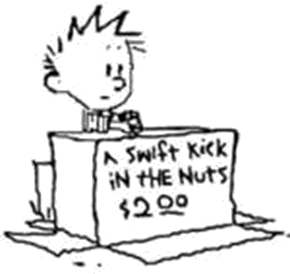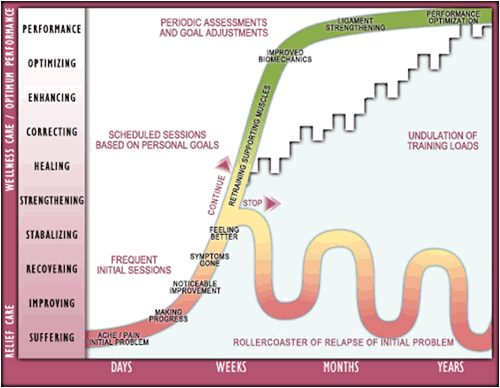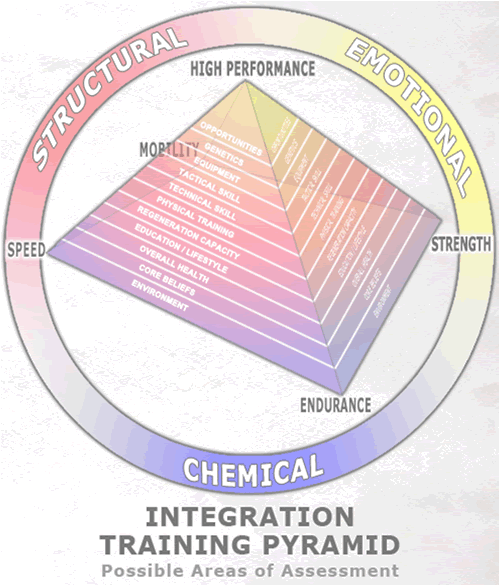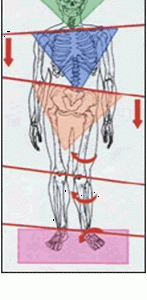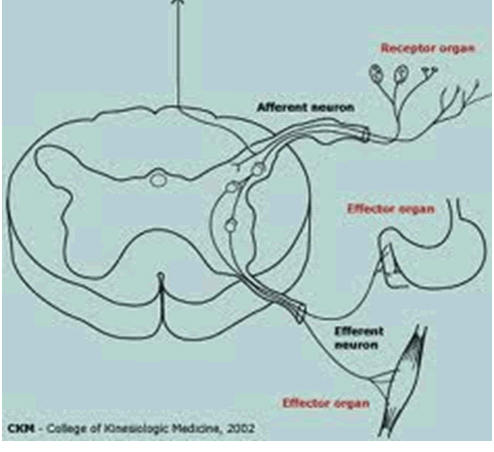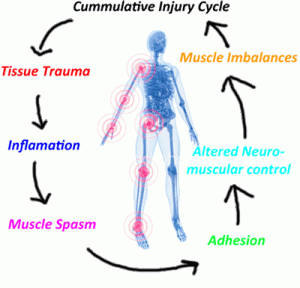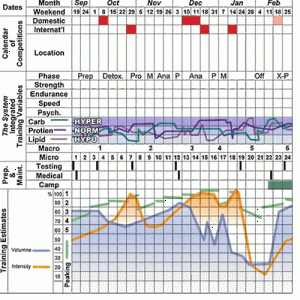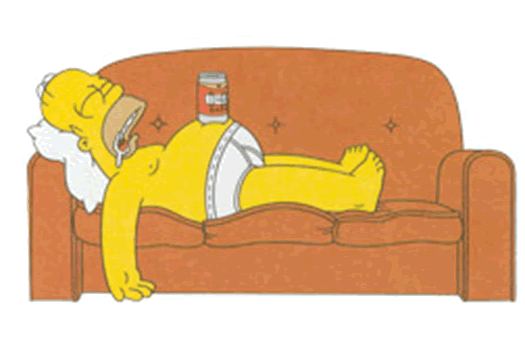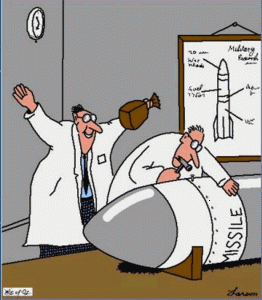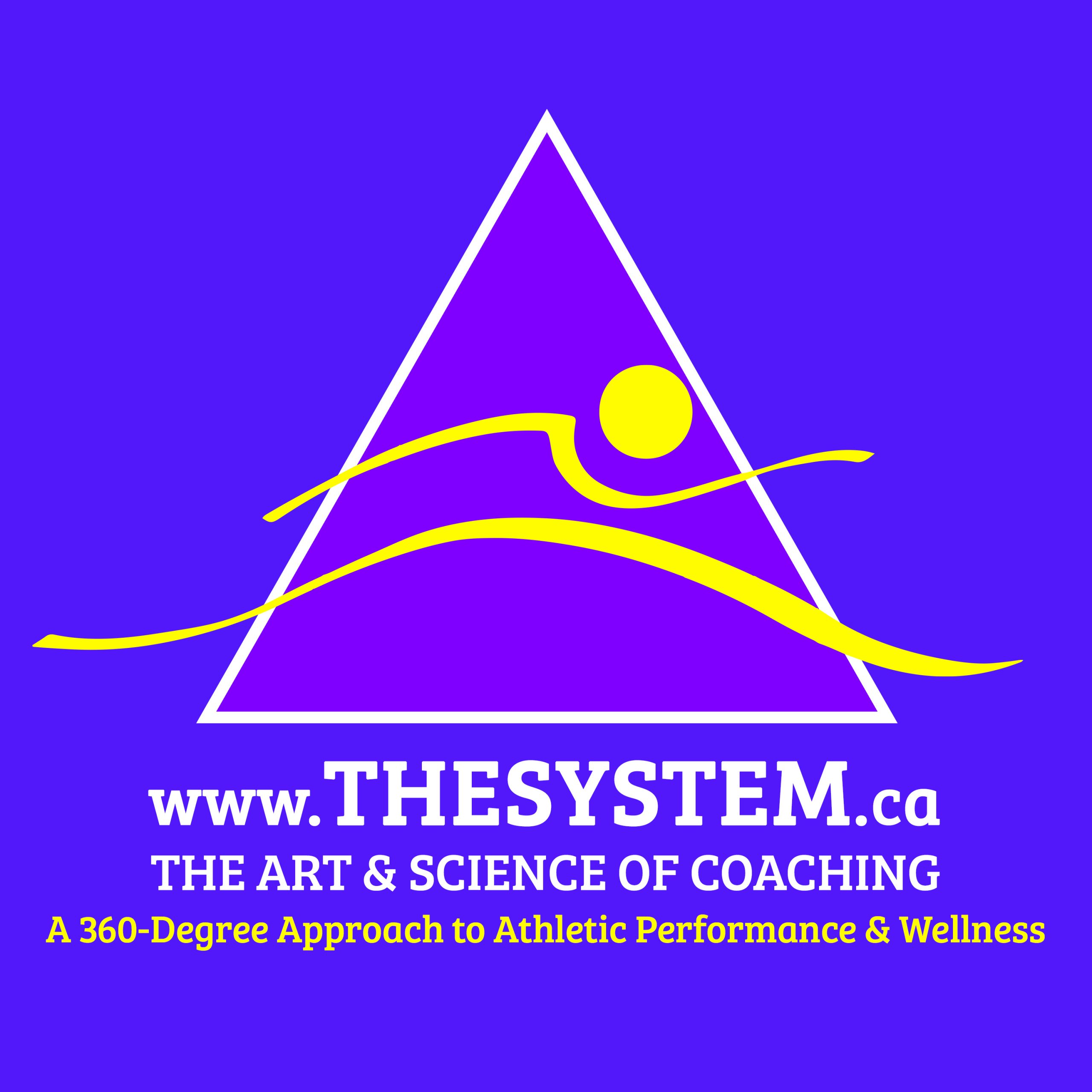“WHY YOU ARE NOT IMPROVING”
PART I OF VI
In this series of articles, I will attempt to address several, sometimes overlooked factors, that could be potentially be crippling your performance. In the subsequent parts, we will explore the following ideas and concepts:
1) The concept of Conditioning as it pertains to Structure
2) Regeneration
3) Overtraining
4) Planning
5) Monitoring of Training
And finally…
6) The Myth of Sport-Specific Conditioning
If your performance has not improved in the past few months or, barring contact type injuries (See Figure 1), you seem to be getting injured a lot,
Copyright 2013 Calvin & Hobbs
Figure 1: “Barring contact injuries, you should not be getting self-sustained injuries while training / competing.”
despite several visits to your chiropractor / physiotherapist, it’s more than likely due to staleness or overtraining…. in other words….
”Your Central Nervous System is shutting down.”
Copyright 2013 www.TheSystem.ca
Figure 2: “what’s holding you back from higher performance?”
A majority of the athletes I come across are either “under regenerated,” over-trained, or both, and / or performing the wrong type of training, which is collapsing the body’s natural elastic energy system (i.e. “they are losing their shocks”) and altering their body’s proprioceptive sensory system (i.e. sensors located in the body, that assist and enhance static posture and dynamic movement) (See Figure: 2 Above).
“Train smarter not harder. Train less. Recover More”
There are many factors that encompass the make-up of an athlete, and therefore lead to high performance. Some of these elements reside externally, some are related to the athlete’s genetic make-up, whilst others are directly related to what the athlete is addressing through his/her training (See Figure 3).
Copyright 2013 www.TheSystem.ca
Figure 3: “A comprehensive assessment may reveal critical elements that are impeding your performance.”
In my experience, 90% of all athletes are training counter to what their body requires, but rather, are training what they see / hear and what their sport dictates (i.e. mimicking movements in the conditioning program that are “Sport-Specific”… I will deconstruct this concept in Part VI of this article). More often than not, athletes need to step outside the box and embrace conditioning that enhances their form. What do I mean by “form?” Form is the ability for the athlete to maintain ideal postural alignment while performing their sport without experiencing bio-mechanical breakdown. If this is maintained, then the proprioceptive mechanisms will not be altered, and thus skilled performance will not suffer (See Figure 4).
Figure 4: “Postural Mechanical Breakdown can lead to altered movement patterns and decreased proprioceptive sensory input, that require sometimes 20%-30% greater energy to complete, thus leading to movement inefficiency.”
For discussion purposes, bio-mechanical breakdown can occur as a consequence of a number of reasons, some of which are too complex and / or too vast to explain within the length and breath of this article. All conditioning does, is allow you to extend your bio-mechanical limit. In an ideal scenario, an athlete will hit their physiological limit well before their bio-mechanical limit. In most cases however, most athletes will do the inverse, thus contributing to excess fatigue from muscles and potentially leaving them more vulnerable to mechanical failure i.e. injuries. For most athletes this gap between their physiological and bio-mechanical limits is quite considerable, leaving them extremely vulnerable to overtraining and injury.
As organs become stressed and overworked, as a consequence of Central Nervous System (CNS) Sympathetic bias, which draws larger volumes of blood flow to the working muscles and away from the visceral organs, this prevents the CNS from achieving the relaxed state of Parasympathetic dominance. It is in this state the brain and the rest of the vital organs repair themselves (i.e. ‘clean house’), restore muscle glycogen to the previously working muscles, etc…, in other words…Deep Sleep. In order to attain this regenerative state of deep sleep, i.e. Rapid Eye Movement (R.E.M) a.k.a. ‘the dream state’). It is in this state that Growth Hormone (GH) and Testosterone (T) are released in large quantities. Therefore, if the athlete is unable to switch to the Parasympathetic CNS state, sleep quality will become poor (i.e. the lack of R.E.M. sleep), thus generating undue stress on the visceral organs. If the organs become stressed, and because they share a common nerve root to various muscles, in turn these muscles will begin to ‘shut down’ (See Figure 5).
Figure 5: “when organs are not fully recovered, muscles will ‘shut down’, which will lead to a state of biomechanical inefficiency.”
As these muscles progressively become weaker, the body tries its best to overcompensate by causing other muscles to bear the burden of additional work in order to maintain form (i.e. posture) and bio-mechanics. Over time this altered state of muscle contraction begins to create local states of rigor in these overtaxed muscles. Slowly other muscles now begin to pick up the slack, only to further compromise the bio-mechanical system. This leads to the formation of adhesion patterns, which add even greater alerted muscle firing patterns. Ultimately, the body begins to develop trigger points in the belly of certain overworked muscles. If left untreated, these trigger points begin to do a number of things: alter muscle tension patterns; compromise the CNS by overriding vital sensory information (via the proprioceptive system) that assists the body to not only maintain a neutral alignment in space; and also disrupting the sensory information needed for gait and other physical activity, namely the sport the athlete participates in. The over arching result is the manifestation of either an increased susceptibility of self-sustained repetitive injury potential and / or the heightened state of acute injury potential (i.e. muscle, ligament and / or tendon tear). In plain and simple terms…the athlete is literally being ‘set-up’ for an injury (See Figure 6).
“Self sustained injuries are the direct consequence of altered Proprioception, which leads to improper muscle firing. Therefore, once the athlete has compromised the normal firing patterns, it is not a matter of “IF,” but rather a matter of “WHEN,” they will experience either a chronic or an acute soft tissue injury.”
Figure 6: Cumulative Injury Cycle can lead to a drop in physical performance by 20% to 30%, and in some cases up to 40%!
A good 4 to 6 years should be spent trying to enhance Structural Fitness, thereafter; another 4 to 6 years should be spent on Structural Performance. The latter refers to the enhancement of posture under the rigors of greater strength and endurance, whereas the former refers to developing good posture under static non-load bearing (i.e. lying horizontal or in the kneeling position & “can you maintain ideal posture under normal day-to-day conditions.”) circumstances.
STRUCTURAL STRUCTURAL PERFORMANCE
FITNESS PERFORMANCE CONDITIONING
A well thought-out yearly training program (See Figure 7) can address these various areas of conditioning (i.e. structural fitness and structural performance).
Once the criteria of these two areas have been addressed adequately, the concept of Performance Conditioning should take precedence. This concept refers to the actual work carried out to enhance competitive outcomes. It is the systematic conclusion of a well thought-out long-term conditioning plan, spanning several years. Most individuals that begin a sport move into this realm much too soon, without the proper athletic background to withstand the rigor of conditioning. Thus they experience “mechanical breakdown,” which, as mentioned earlier, can lead to self-sustained injuries. In Part IV, I will discuss the concept of Exercise Planning in a brief, but informative manner.
Figure 7: A Conditioning Plan for a hypothetical athlete.
In the following article I will focus on the concept of Recovery, Regeneration, and Restoration in greater detail (See Figure 8); all of which are the same concept being referred by the use of different terms.
Copyright 2013 The Simpsons
Figure 8: “Sleep is an excellent way to regenerate after stressful training sessions.”
Recovery is the easiest way to restore and maintain your postural fitness. Postural fitness, or the lack of it, is a good indicator of doing too much, or too much of the wrong training. In my opinion, most athletes are unable to tap into 20% to sometimes 40% of their athletic potential due to improper regeneration, poor Proprioception and altered static postural mechanics resulting from improper training methods, over zealous adherence to the latest fad in conditioning, ritualistic, traditional forms of conditioning. All of which, quite frankly, are undertaken without questioning why, or whether the athlete in question requires this, at this time, in the current state they are in. Moreover, many athletes think they need to train more to get better results. On the contrary, often there are several other impeding factors that are “holding the athlete back” from achieving better performance, many of which DO NOT require additional conditioning, but rather, better understanding of how and why the athlete is responding to the prescribed conditioning method(s). Mechanical, physiological and psychological body awareness, is critical to the dispensing of conditioning, without it, most athletes either under-train, or the majority, over-train. Observation of the body’s response to conditioning does not require a sophisticated laboratory apparatus, but rather, with simple yet precise subjective questions like: “ How do you feel today on a scale of 1 to 10?” (See Figure 9). If the athlete answers below 5 or 6, there might a case for reduced training volume or intensity and/or more regenerative methods.
Copyright 2013 The Far Side
Figure 9: “You don’t have to be “Rocket Scientist” to know why you are not improving …less is more
There is no such thing as ‘bad’ training, just ignorance and the lack of wisdom to see if a particular type of training is enhancing your structure, and by de-facto… your performance.
“Monkey see. Monkey do.”
Therefore, all conditioning does is extend mechanical and physiological breakdown. As mentioned earlier, it is the former that shuts down first, only then does the athlete tap into their physiological limit. Using the wrong type of training and too much of it, the system starts to shut down. Use the right type of training, the correct dose, and the correct restoration, and the system is enhanced. The question then becomes, what is the correct type of training and the right type of restoration? The answer to this question is of course not that simple, but what it will tell you, is that your paradigm for conditioning and regeneration must be broad enough to encompass numerous possibilities; and suffice to say, you must also posses the wisdom in the application of these various conditioning and restoration methods to address the individual needs of each athlete that you work with. Not an easy task, but with enough broad experiences, openness of thought and piercing insight, this task can become almost instinctual.
Stay tuned for part II, as we will discuss in greater detail the art and science of Regeneration.


